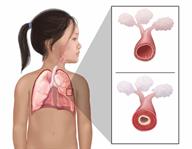Long-Term Narrowing of the Lower Airways (Asthma) in Children: What to Know

Asthma is a long-term disease that causes swelling and narrowing of the airways. The airways are the passages that lead from the nose and mouth down into the lungs. The narrowing is caused by irritation and tightening of the muscle around the child's lower airways.
When asthma symptoms suddenly get worse, it's called an asthma attack. During an asthma attack, your child may have:
There's no cure for asthma. But medicines and lifestyle changes can help to control it. It's important to keep your child's asthma well controlled so it does not affect their daily life.
What are the causes?
The cause of asthma is not known. Some causes of asthma:
Can be passed down through families (inherited).
Can be in the environment.
Can cause an asthma attack or make symptoms worse. These are called triggers.
What can trigger an asthma attack?
Mold, dust, pet dander, or cockroaches.
Pollen, air pollution, and chemical odors.
Cigarette smoke.
Weather changes and cold air.
Stress and strong emotions, such as crying or laughing hard.
Infections, such as the flu, a cold, or pneumonia.
Swelling of the lining of the nose.
Reflux disease, also called GERD.
Exercise or hard physical activity.
What are the signs or symptoms?
-
Wheezing.
-
Trouble breathing, or shortness of breath.
-
Coughing, especially at night or in the morning.
-
Very bad cough, or coughing often when the child has a cold.
-
Chest tightness.
-
Being tired after little activity or play.
-
Trouble talking in complete sentences during an asthma attack.
-
Finding it hard to exercise.
How is this diagnosed?
Asthma may be diagnosed based on:
How is this treated?

There're no cure for asthma. Symptoms can be controlled with treatment. Treatment usually includes:
Knowing your child's asthma triggers and avoiding them.
- Using medicines that your child breathes in (inhalers). There are two types of inhalers:
Controller medicines to prevent symptoms. These are taken every day.
Fast-acting reliever or rescue medicines. These are used during an asthma attack. They treat symptoms quickly. They're used when needed.
Taking medicines for allergies, or medicines to support the child's body defense system (immune system).
Using oxygen when symptoms are very bad.
The health care provider will create a plan for treating your child during an asthma attack. This is called an asthma action plan. The plan includes:
A list of the child's asthma triggers and how to avoid them.
When your child should take their medicines and when to change the dosage.
How to use a device called a peak flow meter. A peak flow meter checks how well your child's lungs are working and how bad the asthma is.
Follow these instructions at home:
-
Give your child medicines only as told.
-
Stay up to date on all your child's shots (vaccines), such as the flu and pneumonia shots.
-
Use a peak flow meter as told by the provider. Record and keep track of your child's peak flow readings.
-
Help your child to avoid triggers.
- Know your child's asthma action plan. Use it during an asthma attack. Make sure that all people providing care for your child:
Have a copy of the asthma action plan.
Know what to do during an asthma attack.
Have medicines, such as inhalers, to treat your child when needed.
-
Do not smoke. Do not let anyone smoke around your child or in your home.
Contact a health care provider if:
-
Your child has wheezing, shortness of breath, or a cough that's not responding to medicines.
-
Your child's medicines are causing side effects, such as a rash, itching, swelling, or trouble breathing.
-
Your child needs reliever medicines more often than 2–3 times per week.
-
Your child's peak flow reading is at 50–79% of their personal best (yellow zone) after following their asthma action plan for 1 hour.
-
Your child has a fever and shortness of breath.
Contact your child's provider right away if:
Your baby is younger than 3 months old and has a temperature of 100.4°F (38°C) or higher.
Your child is 3 months old or older and has a temperature of 102.2°F (39°C) or higher.
Your child has a fever, and they look or act sick in a way that worries you.
If you can't reach the provider, go to an urgent care or emergency room.
-
Your child's peak flow is less than 50% of their personal best (red zone).
-
Your child is getting worse and is not responding to treatment during an asthma attack.
-
Your child is short of breath at rest, or when doing very little physical activity.
-
Your child has trouble eating, drinking, or talking.
-
Your child has chest pain.
-
Your child's lips or fingernails look bluish.
-
Your child is light-headed or dizzy, or they faint.
These symptoms may be an emergency. Do not wait to see if the symptoms will go away. Call 911 right away.
This information is not intended to replace advice given to you by your health care provider. Make sure you discuss any questions you have with your health care provider.

 There're no cure for asthma. Symptoms can be controlled with treatment. Treatment usually includes:
There're no cure for asthma. Symptoms can be controlled with treatment. Treatment usually includes: